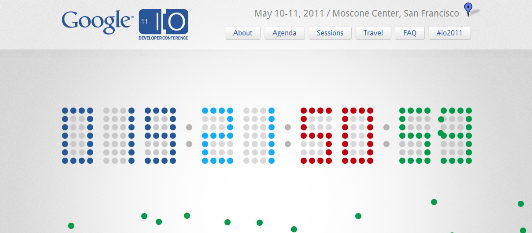I/O 2011Hunches
Google’s recent I/O developer conferences were flush with product launches, app demos, sneak previews, phone giveaways and all sorts of news and goodies. Considering that this year’s I/O sold out in 59 minutes and the bid for an attendee ticket reached $3000 on eBay, Google I/O is all the buzz these days.
The event kicks off on May 10-11 in Moscone Center, San Francisco, and will also be streamed live on Google I/O site and at Google I/O Extended “viewing parties” worldwide (admission free, registration required).
As the conference date nears, Web is getting awash with speculations. Will Android Ice Cream come out in time for I/O? Will Google really release Chrome OS during the event or “later this year”? Will the company launch a new social service that has reportedly been in the works? More important for SEOs, will Matt and the crew host a “SEO site advice from the experts” session this year? It’s not on the list thus far, and Matt is scheduled for the Ignite Tech Talk session only.
What are your hunches for this year’s Google I/O?
I/O 2010 Highlights
During last year’s I/O, Matt (+ Marissa + Tiffany + Greg, but mostly Matt) critiqued a number of sites pointing out frequent optimization issues. Here are some highlights, plus some Matt- cut advice.
Issue #1: duplicate content
Matt suggests that you:
- create original content
- keep away from scraping
- give credit to original authors
Issue#2: little or no text on site
Matt suggests that you:
- write some text yourself
- keep in mind that image-embedded text doesn’t count – search engines can’t read and index it
- mention your keywords “naturally” throughout text
- have visitors create content for you via comments, reviews, descriptions, forums, guest posts etc., which you should probably moderate before posting on your site
Issue#3: site hacked
Matt suggests that you:
- update your CMS regularly
- use Google Webmaster Tools to detect security breaches
- use Google’s Skipfish tool to find and eradicate bottlenecks in your code
- again, moderate user generated content to avoid spam
- protect your site from attacks for the sake of users and search engines: hacked sites get flagged in SERPs as dangerous or get entirely removed from the index
Issue#4: meta descriptions ignored
Matt suggests that you:
- write a compelling, content-relevant meta description – although no longer included in the ranking algorithm, they are still important in site promotion
- treat meta descriptions as your website’s elevator pitch in SERPs. It prompts users to click through, and conversions is the ultimate goal for any site, whether it is SEO-groomed or not
Issue#5: title element not properly optimized
Matt suggests that you:
- take time to write a gripping and informative title – it helps boost rankings and clickthroughs since titles appear in SERPs along with your meta descriptions
- put some keywords in the title (as close to the beginning as naturally possible), and preferably in the URLs as well, if time and money allows
- avoid keyword stuffing and don’t make titles too long (up to 70 characters)
Issue#6: linking out negligently
Matt suggests that you:
- make sure your design company and other partner sites don’t litter your content with their links rife with their keywords – they are taking away your PageRank link by link
- take charge of your site and share link juice with most deserving and content-relevant sites
Issue#7: getting hung up on one keyword
Matt suggests that you:
- think bigger than core target keywords, bashing million-strong competition for one killer search term, and aiming for no less than #1 ranking in Google for it. The end result could be marginal change in rankings plus wasted time and resources
- focus on less competitive (not less relevant) keywords and use concerted keyword effort to generate steady, high-volume traffic
- check your analytics tools and server logs to find keywords you already rank well for and add them to your keyword list
- promote your brand creatively – you don’t necessarily need to go after keyword-rich domain names. Creative webmasters can pick any word and promote it so that users associate a seemingly unrelated word (like Apple) with a brand.
Issue#8: missing out on traffic beyond SERPs
Matt suggests that you:
- explore other venues in addition to traditional SERPs to attract convertible traffic
- find your niche in the universal search listings (news, images, videos, shopping, books, blogs, discussions, realtime and local search), review and social media sites
Issue#9: SEO-unfriendly site layout
Matt suggests that you:
- keep most relevant content above the fold
- put logins, widgets, and other “extras” in the scrollable part, below the fold
- check how the page is viewed in different browsers using Google Browser Size
- create layout that helps users quickly find information they are after
- in SEO, don’t just think rankings; think readership, genuine interest (i.e. natural links), site popularity and quality
Issue#10: “bandwidth limit exceeded”
Matt suggests that you:
- prepare for the worst, and for the best too: is your site ready for fame-driven traffic spikes?
- get a good hosting plan from a reliable service provider to make sure users see your webpage instead of the infamous and heart-rending “bandwidth limit exceeded”
Feel free to share your SEO takeaways from Google I/O 2010 and make bets on the I/O coming forth.






April 26, 2011
good old Matt!